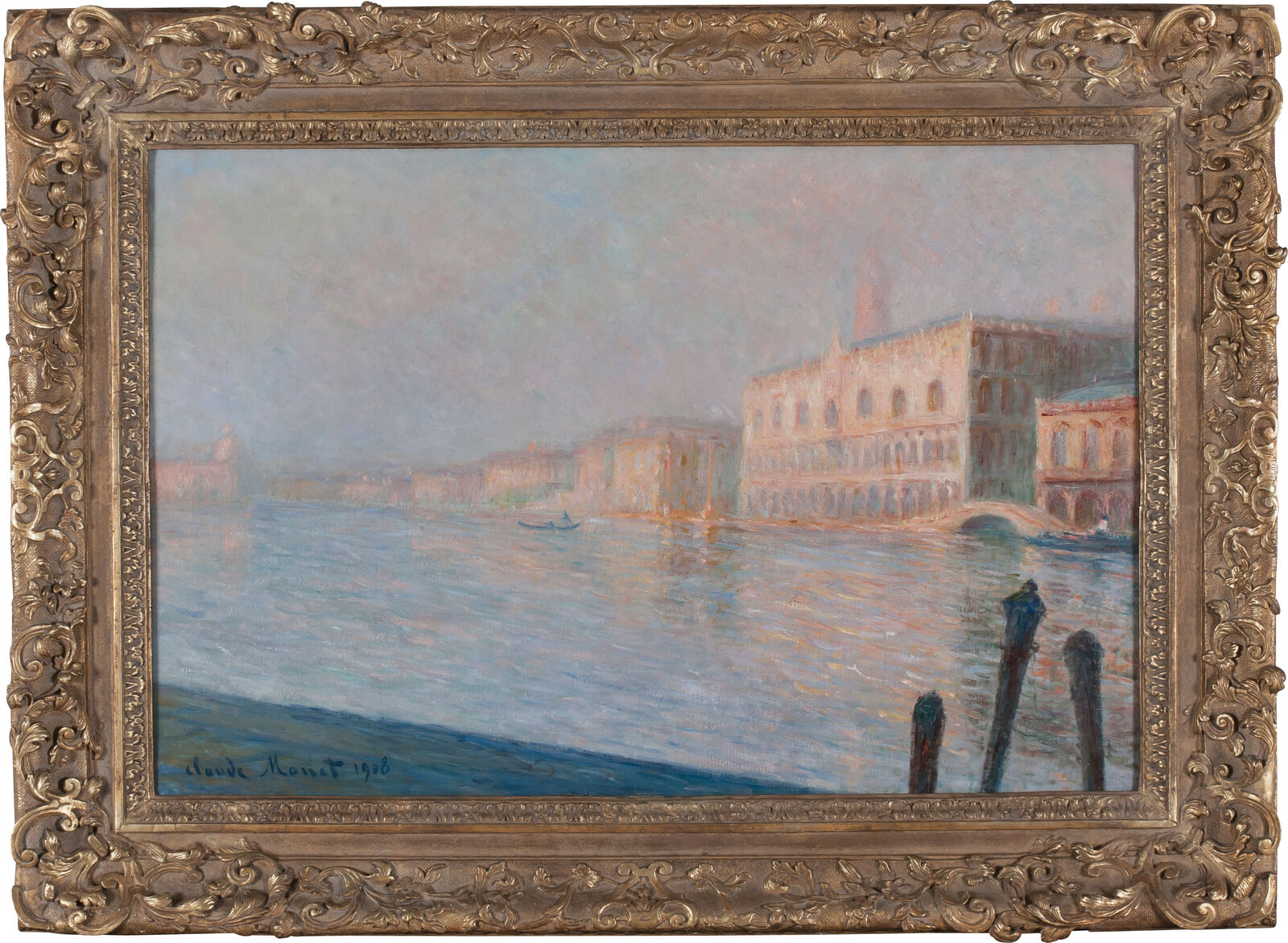Claude Monet
The Palazzo Ducale, 1908
On view at Brooklyn Museum, New York
39 further works by Monet
Copy link
Oil on canvas, 57 x 92 cm
Signed and dated lower left: Claude Monet 1908
Inv.-no. MB-Mon-32
The contours of the Doge’s Palace are clearly outlined, while the other buildings on the Grand Canal and Saint Mark’s Campanile are veiled in mist. The mooring posts on the right, known as pali, intensify the impression of depth in the work. With its atmospheric gradations of color, the picture space is reminiscent of William Turner’s paintings, which Claude Monet studied in London.
In 1908, Claude Monet spent ten weeks in Venice at the invitation of the American patron and society hostess Mary Young Hunter, whom he had met in London around 1900. The art historical significance of the city probably also played a role, since it had captivated some of his most important predecessors, amongst them as J. M. W. Turner and Eugène Boudin. Monet procured several travel guides for his visit, including the Guide Joanne for Italy in a new edition of 1907 and Pierre Gusmann’s copiously illustrated book Venise from the series “Les Villes d’art célèbres” (Famous Art Cities), published in 1902. Many of the motifs that Monet explored in Venice were not only found in Gusmann’s book, but also corresponded to views depicted in paintings by famous artists and which also circulated in more popoluar media such as prints, amateur photographs, or postcards.
Among the best-known buildings in the city was the Palazzo Ducale, the former seat of government for the Republic of Venice. The monumental palace with its cream and pink-colored marble facade and the nearby palazzi along the Bacino San Marco and the north side of the Grand Canal had been standard motifs for 18th-century vedute painting. Monet, too, depicted this building in ten compositions.
This painting is the only one in which the artist adopted a vantage point facing west. To the right we see the Ponte della Paglia and the adjacent prison buildings, the so-called Prigioni. The two bright orange marble columns at the center mark the entrance to the Piazza di San Marco, whose campanile rises up over the Palazzo Ducale in delicate rose tones. The diagonal orientation of the palazzi produces a dynamic quality which is atypical of Monet’s Venetian pictures. While the buildings on the right are rendered with some architectural precision, the background fades into an indistinct swath of haze. A single gondola sketched in rapid strokes of black animates the otherwise deserted scene. The mooring posts in the right foreground enhance the impression of spatial depth.
While the location from which Monet painted all of his other Venetian compositions can be determined, here the vantage point remains unclear. The dark area in the left foreground may depict the edge of a floating, mobile pontoon that would have been positioned in the laguna about at the level of the church of San Giorgio Maggiore. A mobile structure of this kind could explain the very rapid application of paint as well as the artist’s decision to depict the motif only once, rather than in multiple variations as was otherwise typical of his work at that time.
In the four-volume catalogue raisonné of Monet’s paintings compiled by Daniel Wildenstein, The Palazzo Ducale is listed as no. 1770 (vol. 4, pp. 832–33).
Daniel Zamani
Erste Sonderausstellung in Berlin, Tannhauser, Berlin, January/February 1927; Munich and Lucerne, 1927, no. 162
Claude Monet, Tannhauser, Berlin, February 15, 1928–March 1928, no. 67
Venedig: Stadt der Künstler, Bucerius Kunst Forum, Hamburg, October 1, 2016–January 15, 2017, no. 83
Impressionism: The Art of Landscape, Museum Barberini, Potsdam, January 21–May 28, 2017, no. 91
Claude Monet: The Truth of Nature, Denver Art Museum, October 20, 2019–February 2, 2020
Monet: Orte, Museum Barberini, Potsdam, February 22–July 19, 2020, no. 111
Impressionism: The Hasso Plattner Collection, Museum Barberini, Potsdam, from September 5, 2020
Monet and Venice, Brooklyn Museum, New York, October 11, 2025–February 1, 2026; M. H. de Young Memorial Museum, San Francisco, March 21–July 26, 2026, no.
n.d., probably Galerie Bernheim-Jeune,
Paris
n.d., Dr. Hans Wendland, Paris, Berlin and Basel
September 4, 1924, Galerie Thannhauser, Berlin, acquired from the above
April 1, 1926, Erich Goeritz, Berlin, acquired from the above, until at
least March 1928
n.d., Jakob Goldschmidt, Berlin
February 18, 1941, Deutsches Reich, confiscated from the above
September 25, 1941, Hans W. Lange, Berlin, former collection J. G., lot
43
Vereinigte Stahlwerke, acquired at the above sale
1941, Dr. Albert Vögler, Hamburg, acquired as gift from the above
after 1945, Helene Vögler and J. von Martius, Hattingen, inherited from
the above
February 9, 1960, Erwin Goldschmidt, New York, restituted by the above
n.d., Anthony Goldschmidt, inherited from the above
May 5, 2015, Sotheby’s, New York, lot 40, consigned by the above
Daniel Wildenstein, Claude Monet: Biographie et catalogue raisonné, vol. 4, Lausanne 1985, no. 1770, p. 246, ill. p. 247
Daniel Wildenstein, Monet: Catalogue Raisonné. Werkverzeichnis, vol. 4, Cologne 1996, no. 1770, p. 832/33, ill. p. 832
Venedig: Stadt der Künstler, exh. cat. Bucerius Kunst Forum, Hamburg 2016, no. 83, p. 167, ill. p. 167
Impressionism: The Art of Landscape, exh. cat. Museum Barberini, Potsdam 2017, no. 91, p. 226, ill. p. 231
Claude Monet: The Truth of Nature, exh. cat. Denver Art Museum, Denver 2019, no. 111, p. 221, ill. p. 229
Monet: Orte, exh. cat. Museum Barberini, Potsdam 2020, no. 111, ill. p. 229
Do you have suggestions or questions?
sammlung@museum-barberini.de.

